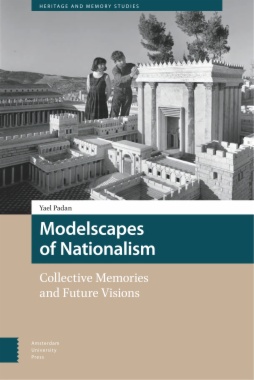Modelscapes are clusters of miniature architectural models that represent entire environments. They're frequently found in museums as representations of heritage, architecture, and collective identity. This book offers a critical analysis of modelscapes, using case studies from Israel, to show how miniature representations of contested physical space participate in the construction of a sense of national identity and appropriation of the land and its history. What, Yael Padan asks, is the meaning of such models, and what role do they play within the context of an ongoing violent conflict over territory and history?
- Cover
- Table of Contents
- Preface
- Introduction: Narratives into Objects, Objects into Narratives
- What are Models?
- Modelscapes
- Case Studies
- 1. The Qualities of Modelscapes
- Models and Modern Modes of Perception
- Visual Perception as a Product of Social Relations
- Visual Objects as Makers of Culture
- Historicizing Visual Culture
- Contemporary Modes of Vision
- Collection and Classification
- The Model as Representation
- The Copy
- Model, Image and Text
- Experience, Performance and Play
- Models and Architecture
- The Perception of Architecture
- On Scale and the Body
- Interior and Exterior Modelscapes
- 2. Models and Modern Perceptions of Nationalism
- The Perception of Time and Modern Nationalism
- Models and the Construction of Collective Identity in Modernity
- Theories of the Emergence of Modern National Identity
- Modelscapes as Representations of National Space
- Modelscapes as Signifiers of National Identity
- Time and Enclosure
- 3. The Second Temple Model
- Designing the Second Temple Model
- The Model of Imperial Rome
- A Serious Plaything
- Authenticity
- The Second Temple Model as a Representation of Archaeology
- The Second Temple Model and the Protestant Perspective
- Representing the Past
- A Vision of the Future
- Relocating the Model
- Who Visits the Second Temple Model?
- Updating the Model
- 4. Mini Israel
- Mini Israel as a Theme Park
- The Politics of the Miniature
- The Politics of Utopia: Planning the Site
- The Politics of the Sign: Choosing the Models
- The Political Economy of Mini Israel
- The Politics of the Exhibition: Mini Israel at the Israel Museum
- The Politics of the Model: A Partial Inventory
- 5. The Valley of the Communities
- Collective Memory and its Sites
- Official Holocaust Memory in Israel
- The Valley of the Communities in the Context of Minimalist Memorials
- Yad Vashem and the Mount of Remembrance
- The Valley of the Communities
- Designing and Building the Site
- Remembering and Forgetting
- The Memorial Ritual at the Valley of the Communities
- Performance and Ritual within Memorial Monuments
- Pilgrimages to Holocaust Memorials
- The Linking Path March
- Conclusions
- Bibliography
- Index
- List of Illustrations
- Figure 1 – The Second Temple Model, general view
- Figure 2 – Mini Israel theme park, general view
- Figure 3 – “Mini Israel”: 70 Models, 45 artists, One Space (exhibition by Larry Abramson), 2006, installation view, Israel Museum, Jerusalem
- Figure 4 – The Valley of the Communities, by Lipa Yahalom – Dan Zur, Landscape Architects
- Figure 5 – Bekonscot Model Village, general view
- Figure 6 – New York Panorama, general view
- Figure 7 – Model of Mont Saint Michel, at the Musée des Plans-Reliefs, Paris
- Figure 8 – The Second Temple Model, general view
- Figure 9 – Detail from the Model of Imperial Rome
- Figure 10 – The Hasmonean Palace, Second Temple Model
- Figure 11 – Second Temple Model at the Israel Museum, Aerial view
- Figure 12 – Moving of the Second Temple Model
- Figure 13 – The Second Temple Model with the Parliament at the background
- Figure 14 – Site plan of the My Land Holyland exhibition
- Figure 15 – Plan of Mini Israel (official map which visitors receive at the site), 2010
- Figure 16 – The Latrun Monastery (at the far background) seen with its model
- Figure 17 – Typical figures at Mini Israel
- Figure 18 – A Bedouin tent at Mini Israel
- Figure 19 – Figures of worshipers covered with protective box
- Figure 20 – “Mini Israel”: 70 Models, 45 artists, One Space (exhibition by Larry Abramson) 2006, installation view
- Figure 21 – “Mini Israel”: 70 Models, 45 artists, One Space (exhibition by Larry Abramson) 2006, installation view
- Figure 22 – “Mini Israel”: 70 Models, 45 artists, One Space (exhibition by Larry Abramson), 2006, installation view
- Figure 23 – “Mini Israel”: 70 Models, 45 artists, One Space (exhibition by Larry Abramson), 2006, installation view
- Figure 24 – Plan of the Valley of the Communities
- Figure 25 – Site plan of Yad Vashem. The Valley of the Communities is no. 14 in the upper left corner
- Figure 26 – The Valley of the Communities, engravings of community names
- Figure 27 – Sketch for the Valley of the Communities. Lipa Yahalom – Dan Zur, Landscape Architects
- Figure 28 – Competition entry, Lipa Yahalom – Dan Zur, Landscape Architects
- Figure 29 – The Valley of the Communities seen from above when approached by foot
- Figure 30 – Visitors next to stone slabs
- Figure 31 – Dramatizing activity at the Valley of the Communities during the Linking Path March, 2010
- Figure 32 – Candles and flowers placed by students on the walls of the Valley of the Communities during the Linking Path March, 2010
- Figure 33 �Students carrying the Israeli flag during the Linking Path March, 2010

